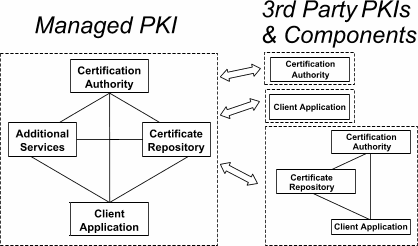
A brief summary of the purpose of each component is as follows:
Summary
of Protocols for PKI Interoperability
ATTENTION
THE
MATERIAL PROVIDED IN THIS DOCUMENT IS FOR INFORMATION PURPOSES ONLY. IT IS NOT
INTENDED TO BE ADVICE. YOU SHOULD NOT ACT OR ABSTAIN FROM ACTING BASED UPON SUCH
INFORMATION WITHOUT FIRST CONSULTING A PROFESSIONAL. IDRBTCA DOES NOT
WARRANT THE QUALITY, ACCURACY OR COMPLETENESS OF THE INFORMATION CONTAINED IN
THIS ARTICLE. SUCH INFORMATION IS PROVIDED "AS IS" WITHOUT
REPRESENTATION, WARRANTY OF ANY KIND, WHETHER EXPRESS, IMPLIED, STATUTORY, BY
USAGE OF TRADE, OR OTHERWISE, AND IDRBTCA SPECIFICALLY DISCLAIMS ANY AND
ALL REPRESENTATIONS, AND WARRANTIES OF MERCHANT ABILITY, SATISFACTORY, QUALITY,
OR FITNESS FOR A SPECIFIC PURPOSE.
1. Enterprise Environment
The Enterprise environment is typified by organizations seeking to provide consistent, transparent security across all end-user applications. The organization has the greatest amount of control in this environment, allowing it to leverage investment in interoperable PKI solutions for both infrastructure and end-users.
Certificate
Generation
- X.509, PKIX Part 1
X.509 defines the format of a public key digital certificate as well as Certificate Revocation Lists (CRLs). PKIX Part 1 provides profiles for each of these two standards.
Certificate
Distribution
- Lightweight Directory Access Protocol (LDAP)
LDAP defines the protocol used to publish and access digital certificates and CRLs from a repository.
Certificate
Management
- PKIX Certificate Management Protocol (PKIX-CMP)
PKIX-CMP defines the protocol for managing keys and certificates. Extends beyond simple certificate request to support PKI lifecycle functions required in the Enterprise.
2.
Inter-Enterprise Environment
The Inter-Enterprise environment is typified by organizations seeking to provide trusted and secure means for business-to-business electronic commerce. The organization has control over its own resources, both infrastructure and end-user, that must interoperate with others' PKIs.
Certificate
Generation
- X.509, PKIX Part 1
These standards also apply to cross
certificates and CRLs used in establishing one to one or hierarchical trust
between enterprises.
Certificate Distribution
- LDAP, S/MIME
LDAP
provides the access protocol for enterprises wishing to share full or partial
certificate repositories. S/MIME defines a protocol that is used for the direct
exchange of digital certificates between end users.
Certificate
Management
- PKIX CMP, PKCS #7/#10
PKIX-CMP
provides protocols for the request and management of cross-certificates, as well
as keys and certificates as in the Enterprise model. PKCS #7/#10 provides
protocols for requesting and receiving keys, certificates and cross-certificates
without any management once created and distributed.
3. Consumer Environment
The
Consumer environment is typified by organizations seeking to enable electronic
commerce with consumers over the Internet. While controlling its infrastructure,
the organization must interoperate with consumers using a wide variety of
applications, typically web browsers and associated e-mail.
Certificate
Generation
- X.509 v3
These
standards provide the profile definition of a public key digital certificate.
While no standards have been approved for revocation checking in this
environment, proposed schemes (ex. OCSP) are under review.
Certificate
Distribution - S/MIME
Distribution
of certificates in this environment is currently limited to direct user to user
communication with S/MIME.
Certificate
Management - PKCS #7/#10
PKCS
#7/#10 supports certificate request and receipt but does not provide for any key
or certificate management. While no standards have been approved for key and
certificate management in this environment, proposed schemes (ex. PKIX-CMC) are
under review.
4.
Elements of PKI Interoperability
Regardless of the environment in which it operates, a Managed PKI is made of up several components that must interoperate. As shown in the figure below, these include interfaces within a single PKI as well as to external environments.

A brief summary of the purpose
of each component is as follows:
Because of their central role
in a Public Key Infrastructure, regardless of the environment, these components
must interact and interoperate. These operations can be summarized as follows: